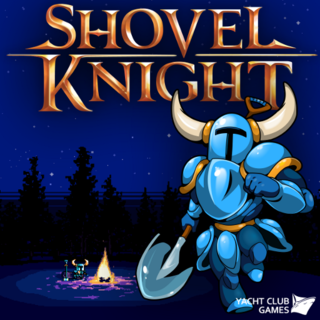INTRO:
The Shovel Knight Kickstarter campaign ended with a lot of secondary targets being achieved. These secondary targets obligated Yacht Club Games to create additional content updates after the release of the game.
One of these updates would be Plague of Shadows, which features a different protagonist and a different perspective on the events of the main game. There are even diverging plot elements, though the writers of Yacht Club Games wrote them off as the consequence of unreliable narrators (which also consequently put the outcome of Shovel of Hope into question).
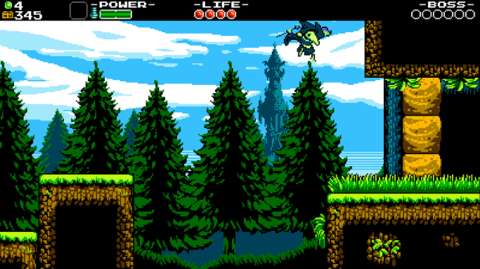
PREMISE:
Plague Knight is one of the bosses in Shovel of Hope. There are many things in that story to suggest that each and every titled Knight in the service of the Enchantress is his own person, or was, in the case of some of the unfortunate ones. Plague Knight, in particular, is quite driven in his pursuit of his own goal.
Plague Knight so happens to be the protagonist of this expansion. His exploits run mostly in parallel with those of Shovel Knight, usually in circumstances that would be believable. He is out to concoct the “Ultimate Potion”, the most potent of potions.
What the potion would do is unclear early on in the story, but what becomes clear soon is that the ingredients would come from characters with particularly notable personality traits. After having made preparations, namely a lab that can receive and preserve the ingredients, Plague Knight intends to turn on the Order of No Quarter.
DIFFERENCES IN NPCS:
Early in the playthrough, it is revealed to the player that some of the people in the Armor Outpost and the Village are actually associates, employees and/or minions of the Plague Knight. The most significant of these is Mona, an NPC that has been previously shown being bored doing paperwork in Shovel of Hope. She is Plague Knight’s research partner.
The Magicist is the lady who provides mana upgrades to the Shovel Knight. She is also providing mana upgrades to the Plague Knight. Percy the anthro-equine ballistician is also revealed to be working on Plague Knight’s arsenal, though it is unclear whether the Plague Knight actually wants his help or not.
Then, there are the Plague Knight’s minions, some of which are shown walking about in his other base, presumably busy with work. Being a sadistic boss, Plague Knight can hit them with his bombs (probably with the excuse of live-testing the bombs on them).
A few new NPCs are introduced in Plague of Shadows, such as Hedge Pupil, who introduces the underground base of Plague Knight after the Plague Knight is denied entry into town. They do not appear to be as interesting as the existing ones who have been updated though.
REUSED ASSETS:
If it is not apparent already, this expansion reuses a lot of assets from Shovel of Hope. The world map is the same, the locales are in the same places and most levels are recycled wholesale where the Plague Knight’s gameplay differences are not an issue. This can give an impression that not much has been done, even though the expansion did come for free on many platforms.
Of course, there is the excuse that the story takes place in the same land and time as Shovel of Hope. People who like Shovel of Hope’s storytelling might appreciate how Plague Knight’s travel through the same places occur differently from those of the Shovel Knight. After all, Plague Knight is persona non grata in the places who are opposed to the Order of No Quarter.
On the other hand, there are some weak but convenient excuses to have everything stay very much the same. For example, Plague Knight has to fight through his own demesne, because his stupid minions have messed things up and went bonkers. (However, the boss of that demesne is replaced by none other than Shovel Knight, who in Shovel of Hope broke into Plague Knight’s base to confront him.)
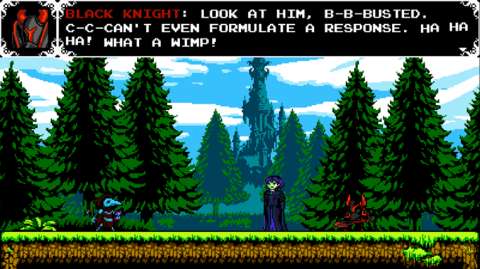
LOCKS NOT MENTIONED IN NARRATIVE:
That said, the locks on the World Map have not been alluded to in either story. This omission is more noticeable in this story, because as a member of the Order of No Quarter – albeit a treacherous turncoat – Plague Knight could have been more able at circumventing the locks than Shovel Knight was. Ultimately, the player would have to accept that the locks are just gameplay designs and no more.
PLAYER CHARACTER DIFFERENCES:
All of the titled Knights are no stranger to combat, but their actual physical prowess still varies. Plague Knight is among the most diminutive of them. It is also notable that he is not wearing any armor.
Consequently, gameplay-wise, Plague Knight is a physical push-over compared to Shovel Knight. When Plague Knight takes a hit, his hit reaction is considerable; he is pushed away from the source of damage by a distance equal to several widths of his sprite. This can be disastrous, especially considering that many levels still retain their onerous densities of instant-death traps. Furthermore, Plague Knight takes more damage from most sources, just like Shovel Knight would if the latter wore the risky magic-absorbing armor.
However, Plague Knight compensates for this frailty in more than a few ways. Indeed, many of these would make him much more capable at platforming than Shovel Knight is.
SHORT JUMPS, BUT DOUBLE JUMPS:
Plague Knight does not jump with as much gusto as Shovel Knight; working in labs does not give as much leg workout as full-time adventuring does. However, Plague Knight does have a double jump, something that completely eludes the Shovel Knight. Thus, the player can have the Plague Knight change direction in mid-air – something that will be very useful in his romps through the levels.
However, the double jump does not reach as much height as the first jump. In fact, their combined vertical reach does not even match that of Shovel Knight’s full-height jump. Therefore, the skilled player would be using the second jump to change directions instead.
CHARGED THIRD JUMP:
Plague Knight’s third jump is the main means of getting about. This has to be charged and released. Upon release, Plague Knight receives a considerable vertical boost upwards. If it is made after the first two jumps, the third jump can reach a total height of four times that of the first jump. This is more than enough to clear vertical distances that the Shovel Knight would have to clear with rebounds.
The double jump can be made before the charged jump, or vice versa; the game will keep track of this when the player character is in mid-air. Neither can be performed again until after the Plague Knight has touched ground. However, the charged jump can be charged while the player character is in mid-air; it just has to be released after Plague Knight hits ground.
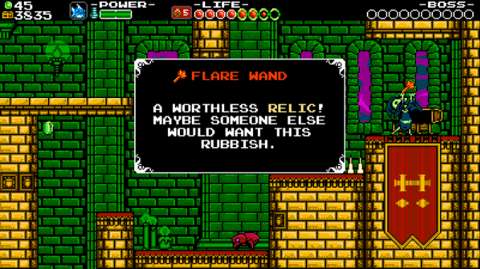
BOMBS:
Plague Knight either does not believe in physical exertions (probably not true), or he has a predilection for explosive methods in combat (much more likely to be true). Thus, his main method of combat is to hurl small but powerful bombs.
Plague Knight begins with the standard-issue variants of the bombs; these have been seen in Shovel Knight’s fight with him in Shovel of Hope. However, in Plague of Shadows, the characteristics of the bombs can be altered on the fly to suit the occasion.
COINS & RESEARCH:
Thanks to Mona’s lab work, Plague Knight only has to concern himself with the field work – which of course include blowing things up. Plague Knight also does the gathering of ingredients and resources – something which he canonically enjoys too, especially if he is stealing them.
For some reason, there are special coins that are floating about the lands; this might be familiar to players who have experienced the Super Mario games, but this would be inexplicable to anyone else. Anyway, these green-coloured coins are “Cypher Coins”; only people like Plague Knight (and Mona) can perceive them. Somehow, the coins can be consumed to further their research, which in turn yields more bomb options for Plague Knight to use.
BOMB OPTIONS - OVERVIEW:
These options are side-grades: none of them provides a permanent straight upgrade. However, as mentioned already, Plague Knight can readily switch between them if the player uses the gear-changing screens. There are controls that are dedicated to switching them in real-time, but using the screen pauses the gameplay, which is perhaps a better way to do so (unless the player has something to prove).
The bomb options are categorized according to three types: casings, powders and fuses.
CASINGS:
Of the three, casings are the most important, because they determine how the bombs move after they leave Plague Knight’s hands.
For example, the standard-issue Bounce casing follows a short upwards arc before falling downwards. For another example, the Arc casing, as its name suggests, has the bombs following a high upwards arc before falling back down (although why Plague Knight needs different casings for the bombs to do either is unclear).
If Plague Knight is in mid-air, the bombs may follow a different path instead, depending on their casing type. Returning to the example of the Bounce casing, the bombs follow a diagonal-downwards path; there is no short upwards arc. The bomb travels faster too.
POWDERS:
Powders are of course the means through which the bombs blow up. The standard-issue powders create gratuitous explosions that can harm multiple enemies, if they are close enough to each other.
Later, the player gains other kinds of powders, which work differently but not necessarily better. For example, there is the Component Powder, which lets the player stack the detonation of bombs together for a bigger explosion later. This takes a while to set up, which may not be in the player’s interest if the current situation is urgent.
Still, there is a time and place for each type of powder, though the wise player is likely to retain the first type of powder because of its generalist utility. For example, the Cluster Bomb powder makes bombs that cannot be blocked so easily, but it only allows for one bomb on-screen.
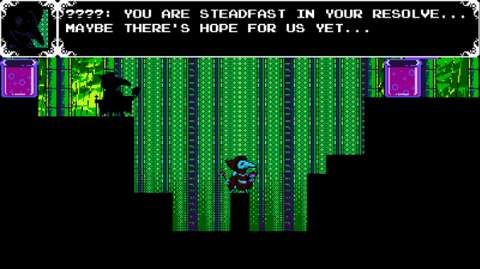
FUSES:
Fuses determine when the bombs detonate. The standard fuse detonates the bombs after about two seconds. There are fuses with shorter or longer delays.
There are also fuses that change the behaviour of the bombs. For example, there is the sentry fuse, which has the bombs suspended in mid-air when they are supposed to detonate. They will linger for several seconds. During that time, they will zoom towards any enemy that happens to get within their (very short) detection ranges.
CONTACT-EXPLOSION:
Anyway, whichever bomb permutation that the player would use, all of them have a few things in common. One of these is that the bombs will immediately detonate if they come into contact with enemies or destructible objects. This is convenient.
The other common occurrence is, of course, the bombs will eventually explode. There is no exception to this.
NUMBER OF BOMBS ACTIVE ON-SCREEN:
The Plague Knight cannot inundate the screen with bombs. There is a hard limit on the number of bombs that can be on-screen. This number depends on the type of powder that is being used. The highest number of bombs is three.
Therefore, the player needs to be careful about when and where to toss bombs, lest the player could not toss them when they are needed.
BLASTS:
The aforementioned charged jump is called “Blasts” in-game. This is because Plague Knight is indeed detonating an explosive somewhere underneath him to propel himself upwards without hurting himself.
Like his bombs, there are side-grade options for Blasts too. In fact, most of these options are practically the starting Blast with more effects. There is no reason to return to the first Blast.
A notable example is the Float Blast. This will likely be the player’s favoured Blast, at least outside of boss fights, because it lets the player control the player character’s descent after the vertical upwards arc.
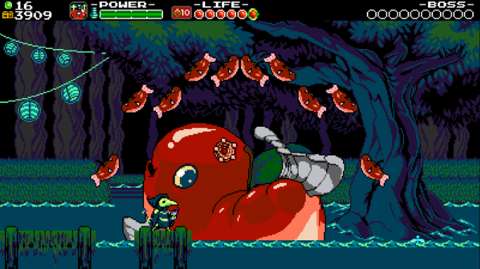
HEALTH:
As mentioned earlier, Plague Knight is a frail player character. It is not likely that a skilled player would get him hurt much outside of boss fights. However, in boss fights, his health is a concern.
The Plague Knight starts with only a few pips to his health meter. He can gain more, but only after having made progress in his storyline; Mona brews potions that he eagerly imbibes to extend his health meter permanently. However, this happens quite rarely, so the player should not depend on these to keep him alive.
TONICS & BUBBLE HEALTH:
Tonics are the Plague Knight’s only portable healing supplies. These work in peculiar ways: if the Plague Knight has less than 10 permanent pips in his health meter, he gains an empty semi-permanent pip when a tonic is consumed, followed by the filling of an empty pip (if any). This semi-permanent pip is known in-game as “bubble health”. This effectively extends his health meter.
As long as the player does not get Plague Knight knocked-out, the semi-permanent pips remain and continue to behave like the permanent pips. However, if he is knocked-out, all bubble health is lost. The player is, of course, not refunded with any of the spent tonics.
Throughout his travels, the Plague Knight may come across tonics as loot. It is generally in the player’s interest to use this as they come, especially if the Plague Knight already has the maximum number of tonics that he can carry.
REPLENISHING TONICS:
The tonics can be replenished at the Potionarium, but this costs a bit of gold. The player also does not get to decide the number of tonics that would be purchased; the tonics are always replenished to the maximum. The costs that are charged are proportional to the number of tonics gained.
After the player has recruited a certain character, that character can replenish tonics for free after every boss fight. This is an advantage that is not told to the player in-game, however.
FOOD:
Plague Knight is a video game protagonist, so he can immediately scarf down food to heal himself. He appears to heal as much as Shovel Knight does upon consuming apples, carrots and whole turkeys, all of which are in Shovel of Hope too. It is notable that food always heals more than tonics, which only give or restore one pip each.
ROBE “DYES”:
Like Shovel Knight, Plague Knight will eventually come across King Trouple. However, King Trouple recognizes Plague Knight as being an amoral person, so he will not give his aid for free.
Gameplay-wise, King Trouple acts like the armourer NPC in Shovel of Hope. Hilariously, Plague Knight would hold out the Chalice, hoping to receive the ichor of King Trouple (which would have been valuable indeed to an alchemist like him). However, instead of spitting into the Chalice, King Trouble (perhaps deliberately, and wisely) douses Plague Knight’s robes and mask instead.
This changes the colour of Plague Knight’s sprite. (This is perhaps an understandable and acceptable case of palette-swapping.) One of the colours is merely there for bling, but the other colours do impart benefits (and some disadvantages) to the Plague Knight.
For example, there is a robe dye that reduces the gold that he loses when he is knocked-out, and which also acts like a treasure magnet when his blast-jump is charged. Indeed, there is no reason to use any other dyes, except for situation-specific occasions.
That said, the dyes can only be changed at King Trouple’s lake, so the player will have to be committed to using any of them. There is no servant of King Trouple that can be found in the levels (due to the Plague Knight’s use of explosive means of fishing).
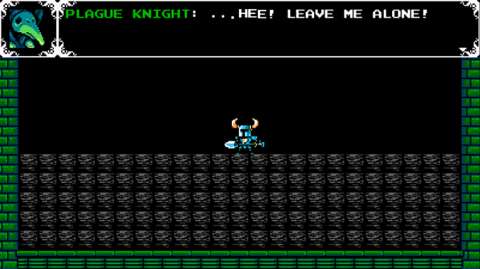
ARCANA & MAGIC:
Unlike Shovel Knight, Alchemist is a practitioner of the magical arts, albeit those of alchemy. Therefore, unlike Shovel Knight, his mana reserves can automatically replenish.
However, perhaps due to his specialization, the Relics that the Shovel Knight can use are unusable to the Plague Knight. Instead, he uses “Arcana” instead.
According to fantastical tropes, there is really not that much difference between “Arcana” and magical “relics”. Actually, the distinction between the two is made for gameplay purposes; any narrative excuse is really just making use of the convenient deus ex machina that is magic in fiction. Plague of Shadows is no different in this matter.
That said, Plague Knight uses Arcana like Shovel Knight would use Relics. The gameplay conveniently pauses to let the player swap between Arcana. Arcana can be used as long as the player character has mana left.
Plague Knight’s Arcana do seem to consume proportionally more mana than Shovel Knight’s however. Indeed, the Plague Knight will not be using Arcana willy-nilly. This is apparently the setback that balances Plague Knight’s automatic replenishment of mana.
MAGIC METER:
Plague Knight’s magic reserves are represented with a meter instead of a counter. The meter has marked sections, each section representing a full unit of magical energy that can be used to power the Arcana. The cheapest Arcana take one section each; the later ones can take three.
However, Plague Knight’s magic meter only starts with two sections in the beginning, meaning that the player character cannot use expensive Arcana until his health meter has been upgraded. Speaking of which, the Magicist is the one that provides these upgrades. (By the way, she keeps dropping hints that she would prefer that the Plague Knight take something that changes his physical appearance.)
BLUE CHESTS & CHESTER:
Chester appears in this expansion too, together with the blue chests. In fact, there are two blue chests in each level. The first occurs exactly where the blue chests are in Shovel of Hope; this one contains one of the Relics that Shovel Knight would use. The second chest occurs elsewhere, where there were not any blue chests in Shovel of Hope’s levels.
The second blue chest happens to reveal none other than Chester. Somehow, Chester is aware that the Plague Knight has collected Relics that are useless to him. Therefore, he suggests a trade, in which he exchanges the Relics with Arcana. Coincidentally, the area of the level around Chester happens to have an obstacle course where the Arcana would be useful.
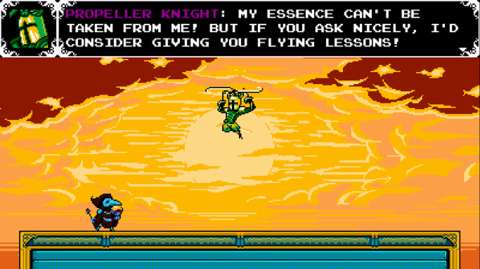
LEECH LIQUID:
As mentioned earlier, tonics are not very effective portable healing sources. Therefore, the Arcana that is Leech Liquid would be the wise player’s preferred way of having the Plague Knight healed.
The Plague Knight has to spend two seconds to drink the Liquid, however. If he is interrupted, the Liquid fails to take effect and the mana to use the Liquid is spent anyway. Therefore, the player will want to have the Plague Knight be somewhere away from enemies before using it.
Amusingly though, he can drink the Liquid even in mid-air; he does the sitting and drinking animation anyway while suspended in mid-air.
STAFF OF SURGING:
The Staff of Surging is also a notable Arcana. This gives the Plague Knight an uppercut attack with a pose that is not unlike that of Juan’s uppercut in Guacamelee! Also, just like the uppercut in that other indie game, this does move the Plague Knight vertically upwards.
This can help a lot in platforming sequences, as well as an optional challenge in Plague of Shadows that involves destroying a lot of paintings. Indeed, the Staff practically provides a fourth jump, or even fifth jump if the player could space out consecutive usages.
However, there is a slight delay between each usage, and the Plague Knight will fall during this delay. In other words, the Staff won’t let the player character accumulate vertical height.
FIGHTING ENEMIES AS PLAGUE KNIGHT:
The capabilities of enemies remain unchanged in Plague of Shadows. However, since the player character plays completely differently from Shovel Knight, the experience of fighting them is not the same.
For one, Plague Knight attacks at range. This gives him considerable advantage over most melee-oriented enemies that would have given the Shovel Knight trouble.
For example, the Goldarmor Knights that can be a bit troublesome for Shovel Knight are not a problem for Plague Knight, who can stagger them with his bombs and render them vulnerable to follow-ups. In fact, their shields will not protect them from Cluster Bombs.
However, the player will need to alter the casings of his bombs a lot in order to adapt to the enemies. For example, flying enemies are best fought with the Arc casing, because most of them are vertically above the player character when they appear on-screen. If the player has yet to gain those casings, these enemies are going to be a problem.
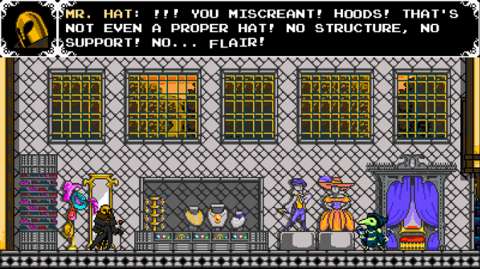
FIGHTING BOSSES AS PLAGUE KNIGHT:
In Shovel of Hope, it takes a short while for Shovel Knight to defeat most enemies, especially if the player knows when to time his downward thrusts and how to control him mid-air in order to enact consecutive rebounds. Plague Knight’s capabilities, of course, do not allow such a strategy, but he can defeat the bosses just as fast.
Plague Knight’s bombs inflict considerable damage on bosses. Indeed, the Orbit fuse is devastating against melee-oriented bosses, especially the Black Knight (and Shovel Knight).
Furthermore, with the use of Arcana like the Leech Liquid, battles of attritions do not occur at all for the Plague Knight. If the player is skilled enough to control the amount of damage received and time the use of the Liquid well, almost any fight would end in victory for the Plague Knight.
However, Plague Knight’s severe hit reaction becomes a major liability in boss fights where instant-death hazards – especially death pits – are introduced into the arena. The first occurrence of this is the fight with Propeller Knight. It is easy for the Plague Knight to be dumped into the holes that is made into the ground partway through the fight.
These fights can be hair-tearing frustrating, especially if the player had been resorting to rush-down tactics against the other bosses.
CHALLENGES:
Like Shovel of Hope, completing Plague of Shadows unlocks post-game content. These include challenges for the Plague Knight. Like the challenges that the Shovel Knight has, these restrict the Plague Knight to specific gear load-outs, magic reserves and health meter lengths. The player’s familiarity with his gear will be vigorously tested.
VISUAL DESIGNS:
Being an expansion, it is understandable that Plague of Shadows uses the same visual assets as Shovel of Hope. However, there are notable additions and differences.
The most prominent of these is of course Plague Knight himself. His sprite has been given more animations and visual effects, as befitting a player character. The most amusing of these new animations are his victory dance, which fits his manic personality quite well.
Then, there is Mona, who undergoes the most amusing change. The switch from her clerical robes to an edgier and form-fitting garb happens early in the game, as part of the revelation that the Plague Knight has a hidden base away from his known base.
There are also some visual effects that were not seen in Plague of Shadows. For example, the vapours that are seen in Plague Knight’s Potionarium were definitely not seen in Explodatorium. Speaking of which, the Potionarium shows a lot of new visuals – namely new animations for existing characters.
Otherwise though, most of the visual effects in Plague of Shadows are simply recycled from Shovel of Hope.
SOUND DESIGNS:
The musical tracks in Plague of Shadows are mostly those that have been heard in Shovel of Hope, albeit with subtle filters to make them sound a bit more playful but also a bit more sinister.
Jake Kaufmann has also composed a few new tracks, specifically those for the locales and situations that are associated with Plague Knight’s exploits. As befitting Plague Knight’s manic and amoral personality, these tracks sound noticeably more ominous than the others, though they share the same whimsical appeal.
New sound effects are a bit more difficult to discern. Other than the sound effects for capabilities that Plague Knight has not exhibited in Shovel of Hope, there are not many other new sound clips.
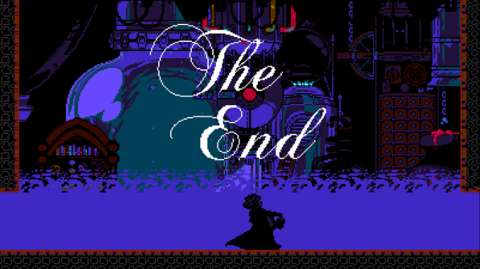
SUMMARY:
If Plague of Shadows added anything to the story of Shovel Knight, it is that the titled Knights are shown to be more than just villainous goons of the big bad villain. The reveal of the “side vocations” of otherwise inconsequential NPCs in Shovel of Hope also highlighted how the writers of Yacht Club Games could develop characters further. This is an achievement that the developer would wisely take as a lesson, as is evident from the next two expansions.
Gameplay-wise, the reusing of many levels might seem like a lazy rehash. However, with a player character that functions differently, replaying those levels is actually quite a different experience. Circumventing obstacles that would have given Shovel Knight trouble provides moments of glee. Of course, some levels have to be redesigned to accommodate Plague Knight as a player character. The problem that is the pervasiveness of instant-death hazards is still around, however.
Overall, this is an expansion that would surprise cynics who have a bad first impression of the game, and the surprise would be a mostly pleasant one.
